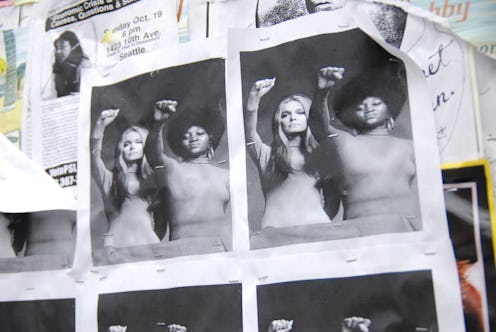
It seems like a given that feminism should try to help all women, especially those who are most disadvantaged. But privileged women don't always realize when they're excluding less privileged groups or how this exclusion harms them — which is why intersectionality is so important. Feminism cannot achieve its goals without intersectionality, and these five facts drive that point home.
The phenomenon of "white feminism" — advocacy for gender equality that ignores the unique experiences of women of color — has brought intersectionality to the forefront of discussions about feminism. For example, after Nicki Minaj called out the exclusion of black women in the entertainment industry on Twitter during this year's VMAs, Miley Cyrus called her "not very polite" — a response that both tone-polices black women and refuses to address racism. This brand of feminism is dangerously common among white women who haven't ever had to think about the experiences of women of color.
By excluding women of color and other marginalized groups, we make feminism a movement that privileges certain perspectives over others — exactly what feminism is trying to combat. In case you need convincing, here are a few facts that prove feminists need to think about more than gender for their feminism to include everyone. This list is by no means exhaustive, but it offers several examples of how, for many groups of people, feminism is not about gender alone.
1. Latina Women Make 54 Percent Of What White Men Make
Let's say a white, non-Hispanic man and a Latina woman both started a new job on Jan. 1, 2014. In order to make as much as he made by Dec. 31, 2014, she would have had to work until last Thursday, October 15, 2015. That's the Latina gender pay gap in action — the fact that Latina women make 54 percent of what white men make for working full-time.
A common argument about the wage gap is that it simply reflects women performing different jobs, but research shows that this doesn't tell the whole story: Renee Davidson points out at Ms. that women are paid less than men for the same jobs within the food service industry, one that contains a disproportionate number of Hispanic people. In addition, the fact that Hispanic women hold different jobs from white men doesn't take away from the problem of unfair payment but rather is a problem in of itself. Hispanic people are less likely to hold college degrees, and only one percent of the computing and engineering workforce consists of Hispanic women.
Black women also face a higher wage gap than white women, making 64 percent of what white men make, and for Native American women, that figure is 65 percent. If we only look at the numbers by gender, we miss how race figures into the problem as well.
2. 12.5 Percent Of Women With Disabilities Were Unemployed In 2014
This is over twice the unemployment rate of the able-bodied, which was 5.9 percent. And the same prejudice and lack of accommodations that have excluded disabled people from the workforce have also excluded them from feminism. Feminist conferences are often inaccessible, readings are often not available in braille, and videos often don't contain transcripts. In addition, feminism has a history of using ableist words like "crippled" and "handicapped" to describe women's disadvantages.
3. 83 Percent Of Women With Disabilities Are Sexually Assaulted Within Their Lifetimes
This is compared to 33 percent of woman overall. Perpetrators of sexual assault often view women with disabilities as easy targets, and victims only report three percent of assaults, often because services like ASL interpreters aren't available to them. The campus sexual assault epidemic feminists are seeking to combat is even worse for students with disabilities: 48 percent of deaf and hard-of-hearing students at one school reported unwanted sexual contact during college.
4. Black Women Are Three To Four Times More Likely To Die During Childbirth In The United States Than White Women
Women of color face a number of other race-based reproductive health disparities, including higher rates of STIs. Black women are also three times as likely as white women to experience an unintended pregnancy. In addition, immigrants are three times as likely as U.S.-born citizens to lack healthcare coverage.
5. Black Transgender Women Have The Highest Rate Of HIV Diagnosis In The United States
Testing sites in California report a 29 percent HIV diagnosis rate for black transgender women, compared to just four percent for men who have sex with men and six percent for transgender women overall. This is likely because trans people and African Americans have less access to healthcare (largely because they are more often unemployed) and healthcare professionals often don't know how to treat them. Healthcare and other systems aren't geared toward people who subvert the gender binary, and that's a feminist issue.
Images: Jonathan McIntosh, Elias Gayles, Elliott Brown/Flickr